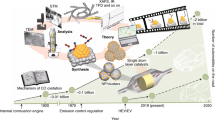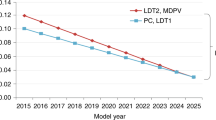Abstract
Pursuance of low reaction temperatures deserves considerable efforts in regard to catalysis for energy efficiency. Catalytic soot combustion, the prevailing technology for reducing the emission of harmful diesel soot particulates, cannot occur efficiently at <200 °C exhaust temperature during frequent idling. Here, we report an electrification strategy aimed at decreasing the ignition temperature at which 50% of soot (T50) is converted at <75 °C using conductive oxides as catalysts, such as potassium-supported antimony-tin oxides. The performance achieved was far superior to that with conventional thermal catalytic soot combustion—generally with T50 >300 °C. Electrically driven release of lattice oxygen from catalysts is responsible for rapid soot ignition at low temperatures, while the opposite electrostatic fluidization between the conductive catalyst and soot particles accounts for improved catalyst–soot contact efficiency. The electrification process presents a promising strategy in meeting the common dilemma of reduction in vehicle emissions at low exhaust temperatures.

This is a preview of subscription content, access via your institution
Access options
Access Nature and 54 other Nature Portfolio journals
Get Nature+, our best-value online-access subscription
$29.99 / 30 days
cancel any time
Subscribe to this journal
Receive 12 digital issues and online access to articles
$119.00 per year
only $9.92 per issue
Buy this article
- Purchase on Springer Link
- Instant access to full article PDF
Prices may be subject to local taxes which are calculated during checkout







Similar content being viewed by others
Data availability
The authors declare that the main data supporting the findings of this study are available within the article and its Supplementary information files. Further data are available from the corresponding author on request. Source data are provided with this paper.
References
Frank, B., Schuster, M. E., Schlogl, R. & Su, D. S. Emission of highly activated soot particulate – the other side of the coin with modern diesel engines. Angew. Chem. Int. Ed. Engl. 52, 2673–2677 (2013).
Shi, Q. L. et al. Multiple strategies to decrease ignition temperature for soot combustion on ultrathin MnO2-x nanosheet array. Appl. Catal. B 246, 312–321 (2019).
Ozel, T., Hall, M. J. & Matthews, R. Increasing exhaust temperature of an idling light-duty diesel engine through post-injection and intake throttling. SAE Int. 2018, 2001–0223 (2018).
Zeng, L. R., Cui, L., Wang, C. Y., Guo, W. & Gong, C. R. In-situ modified the surface of Pt-doped perovskite catalyst for soot oxidation. J. Hazard. Mater. 383, 121210 (2020).
Xiong, J. et al. Efficiently multifunctional catalysts of 3D ordered meso-macroporous Ce0.3Zr0.7O2-supported PdAu@CeO2 core-shell nanoparticles for soot oxidation: Synergetic effect of Pd-Au-CeO2 ternary components. Appl. Catal. B 251, 247–260 (2019).
Portillo-Velez, N. S. & Zanella, R. Comparative study of transition metal (Mn, Fe or Co) catalysts supported on titania: effect of Au nanoparticles addition towards CO oxidation and soot combustion reactions. Chem. Eng. J. 385, 123848 (2020).
Fang, F., Zhao, P., Feng, N., Wan, H. & Guan, G. Surface engineering on porous perovskite-type La0.6Sr0.4CoO3-δ nanotubes for an enhanced performance in diesel soot elimination. J. Hazard. Mater. 399, 123014 (2020).
Jin, B. F. et al. SmMn2O5 catalysts modified with silver for soot oxidation: dispersion of silver and distortion of mullite. Appl. Catal. B 273, 119058 (2020).
Cui, B. et al. Holey Co-Ce oxide nanosheets as a highly efficient catalyst for diesel soot combustion. Appl. Catal. B 267, 118670 (2020).
Cao, C. M. et al. Diesel soot elimination over potassium-promoted Co3O4 nanowires monolithic catalysts under gravitation contact mode. Appl. Catal. B 218, 32–45 (2017).
Chen, H., Zhang, Y. X. & Zhang, J. Dipole-moment-driven diesel soot oxidation in the presence of alkali metal chlorides. Catal. Sci. Technol. 8, 970–974 (2018).
Fang, F. et al. Construction of a hollow structure in La0.9K0.1CoO3-δ nanofibers via grain size control by Sr substitution with an enhanced catalytic performance for soot removal. Catal. Sci. Technol. 9, 4938–4951 (2019).
Xiong, J. et al. Synergetic effect of K sites and Pt nanoclusters in an ordered hierarchical porous Pt-KMnOx/Ce0.25Zr0.75O2 catalyst for boosting soot oxidation. ACS Catal. 10, 7123–7135 (2020).
Wei, Y. C. et al. Design and synthesis of 3D ordered macroporous CeO2-supported Pt@CeO2-δ core-shell nanoparticle materials for enhanced catalytic activity of soot oxidation. Small 9, 3957–3963 (2013).
Mei, X. L. et al. High-efficient non-noble metal catalysts of 3D ordered macroporous perovskite-type La2NiB’O6 for soot combustion: insight into the synergistic effect of binary Ni and B’ sites. Appl. Catal. B 275, 119108 (2020).
Ren, W. et al. Identifying oxygen activation/oxidation sites for efficient soot combustion over silver catalysts interacted with nanoflower-like hydrotalcite-derived CoAlO metal oxides. ACS Catal. 9, 8772–8784 (2019).
Corro, G., Cebada, S., Pal, U. & Fierro, J. L. G. Au0–Au3+ bifunctional site mediated enhanced catalytic activity of Au/ZnO composite in diesel particulate matter oxidation. J. Catal. 347, 148–156 (2017).
Ji, L. et al. Effects of nonthermal plasma on microstructure and oxidation characteristics of particulate matter. Environ. Sci. Technol. 54, 2510–2519 (2020).
Ranji-Burachaloo, H., Masoomi-Godarzi, S., Khodadadi, A. A. & Mortazavi, Y. Synergetic effects of plasma and metal oxide catalysts on diesel soot oxidation. Appl. Catal. B 182, 74–84 (2016).
Lin, H., Huang, Z. & Shangguan, W. F. Temperature-programmed oxidation of soot in a hybrid catalysis-plasma system. Chem. Eng. Technol. 31, 110–115 (2008).
Wismann, S. T. et al. Electrified methane reforming: a compact approach to greener industrial hydrogen production. Science 364, 756–759 (2019).
Dou, L. G. et al. Enhancing CO2 methanation over a metal foam structured catalyst by electric internal heating. Chem. Commun. 56, 205–208 (2020).
Zou, N. et al. Electrothermal regeneration by Joule heat effect on carbon cloth based MnO2 catalyst for long-term formaldehyde removal. Chem. Eng. J. 357, 1–10 (2019).
Wang, K. et al. Energy-efficient catalytic removal of formaldehyde enabled by precisely Joule-heated Ag/Co3O4@mesoporous-carbon monoliths. Carbon 167, 709–717 (2020).
Zhang, Y. et al. A prototype for catalytic removal of formaldehyde and CO in a compact air cleaner powered by portable electricity. Mater. Adv. 1, 3582–3588 (2020).
Li, J., Lu, X., Wu, F., Qin, S. & You, Z. Metallic-substrate-supported manganese oxide as Joule-heat-ignition catalytic reactor for removal of carbon monoxide and toluene in air. Chem. Eng. J. 328, 1058–1065 (2017).
Fino, D., Bensaid, S., Piumetti, M. & Russo, N. A review on the catalytic combustion of soot in diesel particulate filters for automotive applications: from powder catalysts to structured reactors. Appl. Catal. A 509, 75–96 (2016).
Zhang, Y. et al. Characterization of negative temperature coefficient of resistivity in (Sn1−xTix)0.95Sb0.05O2 (x ≤ 0.1) ceramics. J. Mater. Sci. Mater. Electron. 25, 5552–5559 (2014).
Zhang, Z., Zhang, Y., Wang, Z. & Gao, X. Catalytic performance and mechanism of potassium-promoted Mg-Al hydrotalcite mixed oxides for soot combustion with O2. J. Catal. 271, 12–21 (2010).
Aneggi, E. et al. Ceria–zirconia particles wrapped in a 2D carbon envelope: improved low-temperature oxygen transfer and oxidation activity. Angew. Chem. Int. Ed. Engl. 54, 14040–14043 (2015).
Aneggi, E., Llorca, J., Trovarelli, A., Aouine, M. & Vernoux, P. In situ environmental HRTEM discloses low temperature carbon soot oxidation by ceria–zirconia at the nanoscale. Chem. Commun. 55, 3876–3878 (2019).
Serve, A., Boreave, A., Cartoixa, B., Pajot, K. & Vernoux, P. Synergy between Ag nanoparticles and yttria-stabilized zirconia for soot oxidation. Appl. Catal. B 242, 140–149 (2019).
Hajar, Y. M., Boreave, A., Caravaca, A., Vernoux, P. & Baranova, E. A. Isotopic oxygen exchange study to unravel noble metal oxide/support interactions: the case of RuO2 and IrO2 nanoparticles supported on CeO2, TiO2 and YSZ. ChemCatChem 12, 2548–2555 (2020).
Wang, X. et al. Atomic-scale insights into surface lattice oxygen activation at the spinel/perovskite interface of Co3O4/La0.3Sr0.7CoO3. Angew. Chem. Int. Ed. Engl. 58, 11720–11725 (2019).
Yi, D. et al. Regulating charge transfer of lattice oxygen in single-atom-doped titania for hydrogen evolution. Angew. Chem. Int. Ed. Engl. 59, 15855–15859 (2020).
Chen, H., Zhang, Y. & Zhang, J. Dipole-moment-driven diesel soot oxidation in the presence of alkali metal chlorides. Catal. Sci. Technol. 8, 970–974 (2018).
Ramarajan, R., Kovendhan, M., Thangaraju, K., Joseph, D. P. & Babu, R. R. Facile deposition and characterization of large area highly conducting and transparent Sb-doped SnO2 thin film. Appl. Surf. Sci. 487, 1385–1393 (2019).
Krishnakumar, T. et al. Structural, optical and electrical characterization of antimony-substituted tin oxide nanoparticles. J. Phys. Chem. Solids 70, 993–999 (2009).
Bueno-López, A., Krishna, K., Makkee, M. & Moulijn, J. A. Enhanced soot oxidation by lattice oxygen via La3+-doped CeO2. J. Catal. 230, 237–248 (2005).
Piumetti, M., Bensaid, S., Russo, N. & Fino, D. Investigations into nanostructured ceria–zirconia catalysts for soot combustion. Appl. Catal. B 180, 271–282 (2016).
Jelles, S. J., van Setten, B. A. A. L., Makkee, M. & Moulijn, J. A. Molten salts as promising catalysts for oxidation of diesel soot: importance of experimental conditions in testing procedures. Appl. Catal. B 21, 35–49 (1999).
Bologa, M. K., Berkov, A. B. & Solomyanchuk, V. L. Heat-transfer processes enhancement and control with electrodynamic fluidization. Exp. Therm. Fluid Sci. 3, 480–486 (1990).
Bologa, M. K. & Berkov, A. B. Fluidization of electrically conductive particles in an electric force field. J. Eng. Phys. 53, 802–807 (1987).
Higuera, F. J. Analysis of electrodynamic fluidization. J. Fluid Mech. 854, 261–292 (2018).
Acknowledgements
We thank the National Natural Science Foundation of China (nos. 22076062, 21876061, 22072170 and 21906063), the Chinese Academy of Sciences (no. QYZDB-SSW-JSC037), the Fujian Institute of Innovation, Chinese Academy of Sciences (no. FJCXY18020202), the LiaoNing Revitalization Talents Program (no. XLYC1802076) and the Key Technology R&D Program of Shandong Province (no. 2019GSF109042).
Author information
Authors and Affiliations
Contributions
Y.Z., J.Z. and Z. Zhang conceived the research and developed experiments. J.Z. and Z. Zhang supervised the work. X.M. conducted all experiments with the help of X.Z. Y.Z. designed the reaction system and developed the corresponding computer software. X.Z. designed the isotopic oxygen exchange tests and built the apparatus. Y.Z., Z. Zhang and X.M. wrote the manuscript. Z. Zhong and Y.X. contributed to revision of the manuscript and data analysis.
Corresponding authors
Ethics declarations
Competing interests
The authors declare no competing interests.
Additional information
Peer review information Nature Catalysis thanks the anonymous reviewers for their contribution to the peer review of this work.
Publisher’s note Springer Nature remains neutral with regard to jurisdictional claims in published maps and institutional affiliations.
Supplementary information
Supplementary Information
Supplementary Figs. 1–16 and Tables 1–3.
Supplementary Video 1
Movement of K/ATO particles under an electric field.
Supplementary Video 2
Movement of soot particles under an electric field.
Source data
Source Data Fig. 1
Plot source data.
Source Data Fig. 3
Plot source data.
Source Data Fig. 4
Plot source data.
Source Data Fig. 5
Plot source data.
Source Data Fig. 6
Plot source data.
Source Data Fig. 7
Plot source data.
Rights and permissions
About this article
Cite this article
Mei, X., Zhu, X., Zhang, Y. et al. Decreasing the catalytic ignition temperature of diesel soot using electrified conductive oxide catalysts. Nat Catal 4, 1002–1011 (2021). https://doi.org/10.1038/s41929-021-00702-1
Received:
Accepted:
Published:
Issue Date:
DOI: https://doi.org/10.1038/s41929-021-00702-1
This article is cited by
-
Enhancing soot oxidation using microtextured surfaces
Scientific Reports (2024)
-
A single site ruthenium catalyst for robust soot oxidation without platinum or palladium
Nature Communications (2023)
-
Boosting methylcyclohexane dehydrogenation over Pt-based structured catalysts by internal electric heating
Nano Research (2023)
-
Bioresource Upgrade for Sustainable Energy, Environment, and Biomedicine
Nano-Micro Letters (2023)
-
Metal–Support Interactions on Ag/Co3O4 Nanowire Monolithic Catalysts Promoting Catalytic Soot Combustion
Transactions of Tianjin University (2022)



